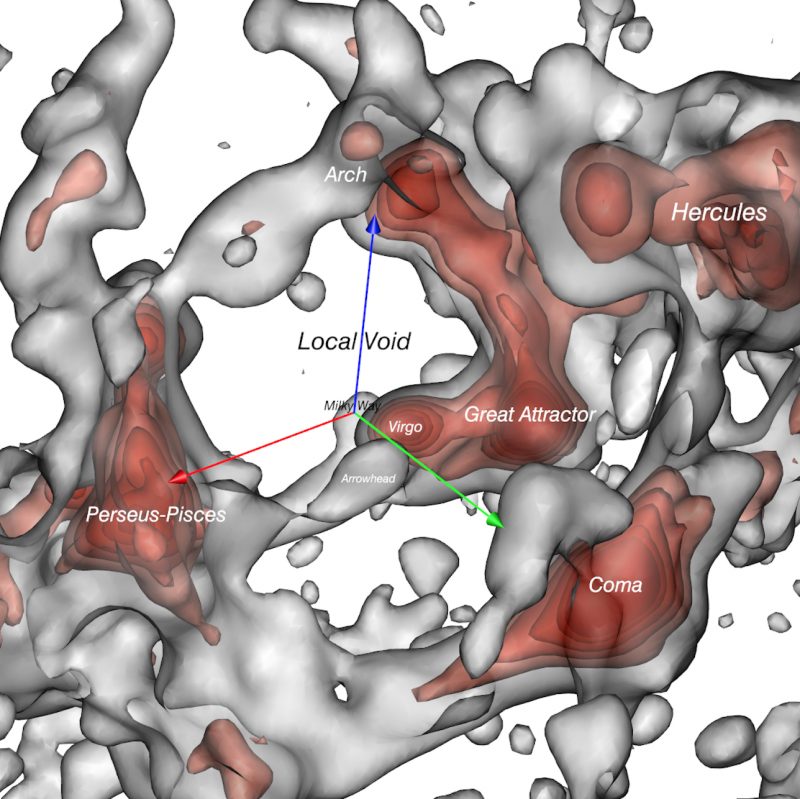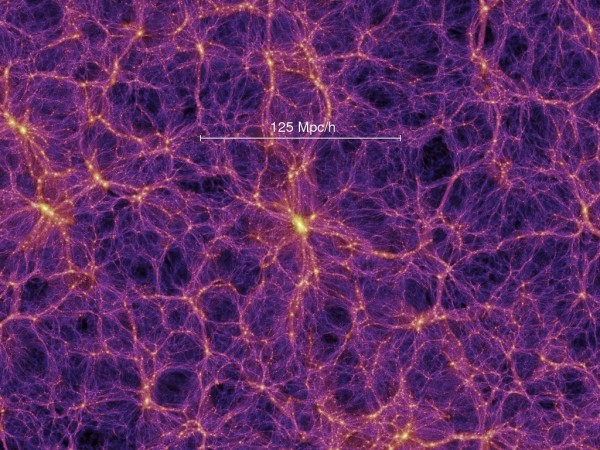
Astronomers have published a new study showing more of the vast cosmic structure surrounding our Milky Way galaxy. In recent decades, they’ve realized that our universe has a vast honeycomb structure, consisting of conglomerations of galaxies interspersed with voids. A team that measured the motions of 18,000 galaxies has now used those motions to infer how mass is distributed in our neighborhood of space. They’ve constructed three-dimensional maps of our local universe, showing the Milky Way’s place with respect to our local cosmic void, which they call the Local Void. This work was led by R. Brent Tully of the University of Hawaii Institute for Astronomy (IfA). In 2014, he led research identifying the full extent of our home supercluster of over one hundred thousand galaxies, giving it the name Laniakea, meaning “immense heaven” in Hawaiian. He and his team have now (fittingly) published a new study on the Local Void. The study was published on July 22, 2019, in the peer-reviewed Astrophysical Journal.
They’ve created some interesting views of their work including an interactive video, which you can see and play around with here. With the interactive model, you can pan, zoom, rotate, and pause/activate the time evolution of movement along orbits. The orbits are shown in a reference frame that removes the overall expansion of the universe. What we are seeing are the deviations from cosmic expansion caused by the interactions of local sources of gravity.
Representations of the void can also be seen in a video (below).
These astronomers commented in a statement:
The universe is a tapestry of galaxy congregations and vast voids.
It’s only been in recent decades that astronomers have identified this tapestry of galaxies and voids in space. If we can go back a bit to some earlier work by another group … in 2005, the Max Planck Society’s Supercomputing Center in Garching, Germany, was used to run a month-long simulation in which the large-scale structure of the universe was charted. You can see the result of their simulation in the image below. Now we’re looking not at our local neighborhood of space, but at a region of space billions of light-years across. Note the line marked 125 Mpc. That is 125 megaparsecs with each megaparsec equal to a distance of a million parsecs (there are about 3.3 light-years to a parsec).

In the new study being reported now, Tully and his team apply the same tools from their earlier studies to map the size and shape of an extensive empty region they call the Local Void, bordering our Milky Way galaxy. From the statement:
Galaxies not only move with the overall expansion of the universe, they also respond to the gravitational tug of their neighbors and regions with a lot of mass. As a consequence, relative to the overall expansion of the universe they are moving towards the densest areas and away from regions with little mass – the voids.
Although we live in a cosmic metropolis, back in 1987 Tully and Richard Fisher noted that our Milky Way galaxy is also at the edge of an extensive empty region that they called the Local Void. The existence of the Local Void has been widely accepted, but it remained poorly studied because it lies behind the center of our galaxy and is therefore heavily obscured from our view.
Now, Tully and his team have measured the motions of 18,000 galaxies in the Cosmicflows-3 compendium of galaxy distances, constructing a cosmographic map that highlights the boundary between the collection of matter and the absence of matter that defines the edge of the Local Void.
Cosmicflows-3: Cosmography of the Local Void from Daniel Pomarède on Vimeo.
These astronomers also said that:
For 30 years, astronomers have been trying to identify why the motions of the Milky Way, our nearest large galaxy neighbor Andromeda, and their smaller neighbors deviate from the overall expansion of the universe by over 600 km/s (1.3 million mph). The new study shows that roughly half of this motion is generated “locally” from the combination of a pull from the massive nearby Virgo Cluster and our participation in the expansion of the Local Void as it becomes ever emptier.
Bottom line: Astronomers have mapped gigantic structures encompassing vast, dense clusters of galaxies and bubble-like voids among them, with the Milky Way between the Local Void and the denser Virgo Cluster.











